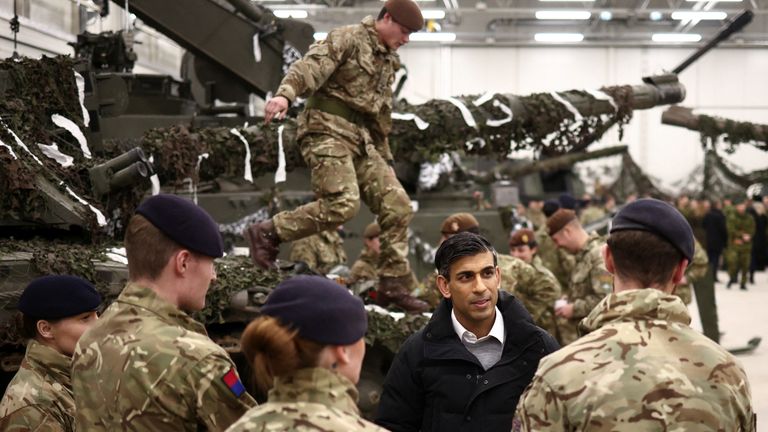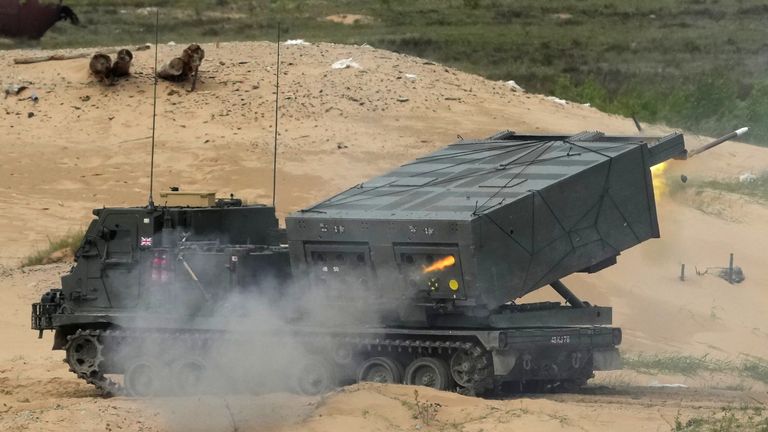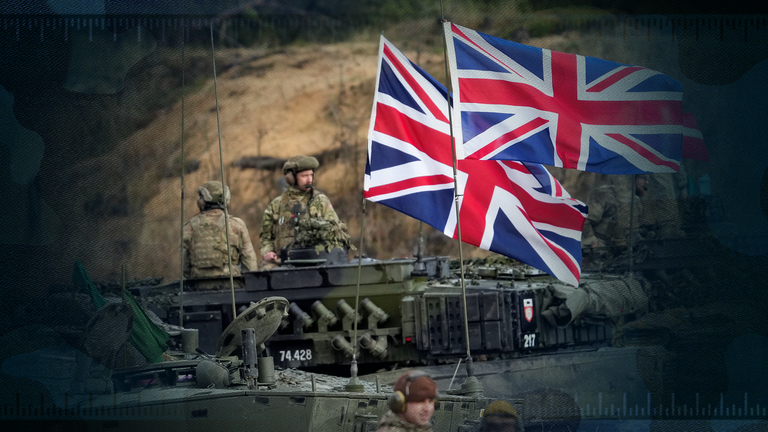A senior US general has privately told Defence Secretary Ben Wallace the British Army is no longer regarded as a top-level fighting force, defence sources have revealed.
They said this decline in war-fighting capability – following decades of cuts to save money – needed to be reversed faster than planned in the wake of Russia’s war in Ukraine.
“Bottom line… it’s an entire service unable to protect the UK and our allies for a decade,” one of the defence sources said.
The sources said Rishi Sunak risked failing in his role as “wartime prime minister” unless he took urgent action given the growing security threat posed by Vladimir Putin’s Russia.
This should include increasing the defence budget by at least £3bn a year; halting a plan to shrink the size of the army even further; and easing peacetime procurement rules that obstruct the UK’s ability to buy weapons and ammunition at speed.
“We have a wartime prime minister and a wartime chancellor,” one source said.
“History will look back at the choices they make in the coming weeks as fundamental to whether this government genuinely believes that its primary duty is the defence of the realm or whether that is just a slogan to be given lip service.”
Is The Army Fighting Fit? Watch our special programme tonight at 7pm on Sky News
Offering a sense of the scale of the challenge faced by the army, Royal Navy and Royal Air Force, it is understood that:
- The armed forces would run out of ammunition “in a few days” if called upon to fight
- The UK lacks the ability to defend its skies against the level of missile and drone strikes that Ukraine is enduring
- It would take five to 10 years for the army to be able to field a war-fighting division of some 25,000 to 30,000 troops backed by tanks, artillery and helicopters
- Some 30% of UK forces on high readiness are reservists who are unable to mobilise within NATO timelines – “so we’d turn up under strength”
- The majority of the army’s fleet of armoured vehicles, including tanks, was built between 30 to 60 years ago and full replacements are not due for years
European powers like France and Germany have announced plans to boost defence spending significantly following Russia’s full-scale invasion of Ukraine last year.
Putin ‘at war with the West’
The European Union has even said President Putin is now at war with the West and NATO.
But the UK’s chancellor-turned-prime minister just wants the problem “to go away”, a second source claimed.
Read more:
Sending Ukraine tanks weakens UK forces, says Army’s top general
UK orders thousands of new anti-tank weapons in £229m deal
Mr Sunak has yet to make any meaningful pledge to expand his defence coffers, instead pursuing a “refresh” of a review of defence policy that is due to be published on 7 March ahead of a spring budget that will signal whether there is any new money for the military.
While the picture is bleak across the military, the army is in a particularly bad place.
Plans exist to modernise the service with fighting vehicles, missiles and upgraded tanks but they were devised before Russia launched its war and the timeline to deliver the transformation is too slow to meet the heightened risk, according to the defence sources.
Such concerns are not just being expressed by individuals inside UK defence circles, with sources saying a high-ranking US general offered a frank assessment of the British Army to Mr Wallace and some other senior officials last autumn.
The general used a term to rank the strength of a country’s military, with tier one regarded as a top-level power such as the United States, Russia, China and France and a status the UK also seeks to hold.
Tier two would describe a more middling power with less fighting capability such as Germany or Italy.
According to the sources, the general, referring to the army, said: “You haven’t got a tier one. It’s barely tier two.”
One of the sources insisted that the US and the rest of NATO understands the UK is planning to rebuild its force.
“It’s now in a better cycle with a lot of new investment over the next ten years”, the source said.
“As long as they don’t screw up the procurement, they’re on track to be a modern army.”
But other sources were less confident about how the UK was being viewed by its allies.
Defence crisis a long time coming
The crisis in defence has been a generation in the making following repeated reductions in the size of the three armed services since the end of the Cold War by successive Conservative, coalition and Labour governments to save money for peacetime priorities.
Compounding the impact of the cuts is a chronic failure by the Ministry of Defence and the army over the past 20 years to procure some of its most needed equipment – such as armoured vehicles and new communication systems – despite spending billions of pounds.
In addition, the need to supply Ukraine with much of the army’s remaining stocks of weapons and ammunition to help the Ukrainian military fight Russia has increased the pressure even further.
The UK is playing a key role in supporting Kyiv, with the prime minister becoming the first leader to promise to send Western tanks – a leadership role he appeared keen to highlight when he took to social media after Germany and the US followed suit.
“Really pleased they’ve joined the UK in sending main battle tanks to Ukraine,” Mr Sunak tweeted last Wednesday.
“We have a window to accelerate efforts to secure a lasting peace for Ukrainians. Let’s keep it up.”
Yet despite this tough talk, Mr Sunak failed to list fixing capability gaps in his own armed forces as being among his top five priorities in his first policy speech as prime minister in early January even as Russia’s war rages on in Europe.
“The PM’s wartime approach is currently to cut the army, hollow it out further by gifting [equipment to Ukraine] and with no plans to replace [the weapons] for five to seven years,” the first defence source said.
In 2020, Boris Johnson, as prime minister, increased defence spending by £16bn – the biggest uplift since the Cold War, but not enough to plug the gaps.
Since then, rising inflation, foreign exchange rates and the need to accelerate modernisation plans in the wake of Ukraine will mean more cuts without new cash, the sources said.
‘Hollow force’
The chronic erosion has created what defence sources describe as a “hollow force”, with insufficient personnel, not enough money to train and arm those still on the books, out-dated weapons and depleted stockpiles of ammunition and spare parts.
It has long been a concern, but Mr Putin’s invasion of Ukraine has created an added sense of urgency – though seemingly not yet inside Number 10, according to General Sir Richard Barrons, a former senior commander.
“The money needed to fix defence is small when compared to other areas of spending like health, welfare and debt interest. So this is a matter of government choices, not affordability,” he told Sky News.
“Defence can no longer be left at the bottom of the list… Why is this lost on Downing Street and the Treasury, but not in Paris or Berlin?”
Mr Sunak has so far resisted calls to follow his predecessor, Liz Truss, to lift defence spending to 3% of GDP by 2030 up from just over 2% at present.
NATO requires all allies to spend at least 2% of national income on defence – a minimum baseline that France and Germany have previously failed to meet but have pledged to achieve.
Army smallest since Napoleonic times
At just 76,000 strong, the British army is less than half the size it was back in 1990 and the smallest it has been since Napoleonic times.
The force is due to shrink even further to 73,000 under current plans that will be implemented unless new money is found.
Retired generals, admirals and air chief marshals have been sounding the alarm for years, finding their voices typically after choosing to stay quiet while in uniform.
But unusually, even serving officials have started to speak more bluntly in public about their depleted capabilities – a clear signal of serious concern within the Ministry of Defence’s main building and at the headquarters of the three services as well as strategic command.
‘Known capability risks’
Appearing before a committee of MPs earlier this month, Lieutenant General Sharon Nesmith, deputy chief of the general staff, spoke about the army’s plans to modernise, which were set out in 2021 as part of a body of work that was done in line with the government’s integrated review.
It envisaged delivering a war-fighting division, supported by new armoured vehicles and long-range missiles to be created by 2030 – leaving an interim gap.
“There were known capability risks,” Lt Gen Nesmith said in her evidence to MPs on the defence select committee.
“I think that, through today’s lens of war in Ukraine, on land, some of those decisions feel very uncomfortable.”
A government spokesperson said: “The prime minister is clear that we have to do everything necessary to protect our people, which is why the UK has the largest defence budget in Europe and we made the biggest investment in the UK defence industry since the Cold War in 2020.
“We are ensuring our armed forces have the equipment and capability they need to meet the threats of tomorrow, including through a fully-funded £242bn 10-year equipment plan.”
Regrowing military capability – something most European nations are also having to do – is difficult, particularly because of the need to balance support to the UK’s own defence industry and jobs against securing bulk purchases at a competitive price.
A separate defence source said: “The defence secretary has made clear for years now, about the need to modernise our army to ensure it keeps pace with our allies.
“That’s why at the spending review in 2020 he achieved an extra £16bn… Reinvesting, learning lessons from Ukraine and growing industrial skills takes time.
“We are on track to start to see new tanks, personnel carriers and air defence systems by the year after next. Over the next few years, Britain will rightly regain its place as one of the leading land forces in Europe.”























